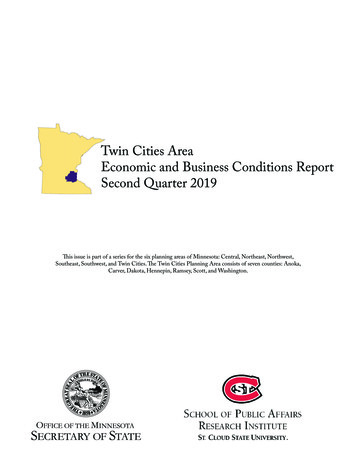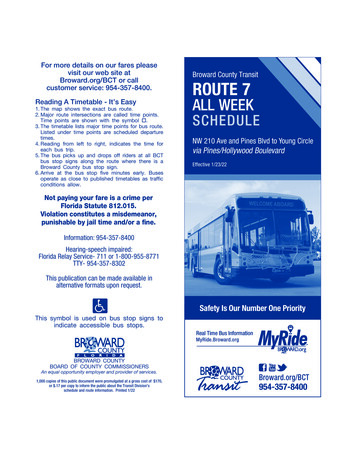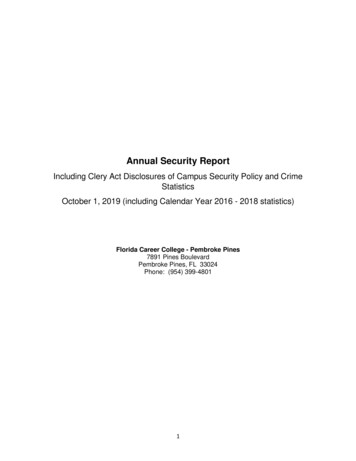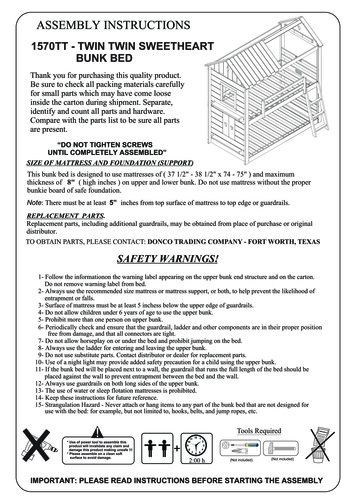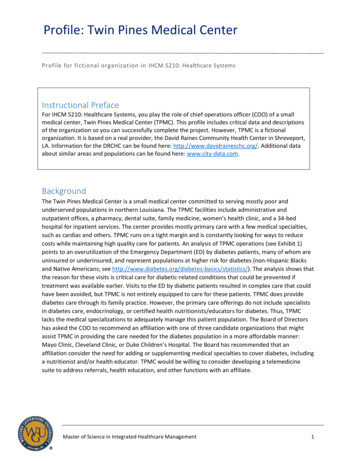
Transcription
Profile: Twin Pines Medical CenterProfile for fictional organization in IHCM 5210: Healthcare SystemsInstructional PrefaceFor IHCM 5210: Healthcare Systems, you play the role of chief operations officer (COO) of a smallmedical center, Twin Pines Medical Center (TPMC). This profile includes critical data and descriptionsof the organization so you can successfully complete the project. However, TPMC is a fictionalorganization. It is based on a real provider, the David Raines Community Health Center in Shreveport,LA. Information for the DRCHC can be found here: http://www.davidraineschc.org/. Additional dataabout similar areas and populations can be found here: www.city-data.com.BackgroundThe Twin Pines Medical Center is a small medical center committed to serving mostly poor andunderserved populations in northern Louisiana. The TPMC facilities include administrative andoutpatient offices, a pharmacy, dental suite, family medicine, women’s health clinic, and a 34-bedhospital for inpatient services. The center provides mostly primary care with a few medical specialties,such as cardiac and others. TPMC runs on a tight margin and is constantly looking for ways to reducecosts while maintaining high quality care for patients. An analysis of TPMC operations (see Exhibit 1)points to an overutilization of the Emergency Department (ED) by diabetes patients, many of whom areuninsured or underinsured, and represent populations at higher risk for diabetes (non-Hispanic Blacksand Native Americans; see /). The analysis shows thatthe reason for these visits is critical care for diabetic-related conditions that could be prevented iftreatment was available earlier. Visits to the ED by diabetic patients resulted in complex care that couldhave been avoided, but TPMC is not entirely equipped to care for these patients. TPMC does providediabetes care through its family practice. However, the primary care offerings do not include specialistsin diabetes care, endocrinology, or certified health nutritionists/educators for diabetes. Thus, TPMClacks the medical specializations to adequately manage this patient population. The Board of Directorshas asked the COO to recommend an affiliation with one of three candidate organizations that mightassist TPMC in providing the care needed for the diabetes population in a more affordable manner:Mayo Clinic, Cleveland Clinic, or Duke Children’s Hospital. The Board has recommended that anaffiliation consider the need for adding or supplementing medical specialties to cover diabetes, includinga nutritionist and/or health educator. TPMC would be willing to consider developing a telemedicinesuite to address referrals, health education, and other functions with an affiliate.Master of Science in Integrated Healthcare Management1
History and Mission of TPMCThe Twin Pines Medical Center is defined by its mission and values to provide accessible, affordable,comprehensive, and quality healthcare services to the communities it serves, regardless of race, nationalorigin, or ability to pay. The commitment to service is grounded in the principle “Putting People First.”Everyone at Twin Pines Medical Center prides themselves in ensuring that all families—insured,uninsured, underserved—have the opportunity to receive quality medical services. The mission andvalues of Twin Pines Medical Center are firmly rooted in the origins of the institution.Twin Pines Medical Center is named after the Twin Pines Home for Boys, founded by Mr. HermanRaynes, the benefactor, noted businessman, community builder, and philanthropist. Mr. Raynes wasborn in Dexter, Arkansas, in 1860. His family moved to northern Louisiana, where he became asuccessful and prosperous farmer in Pine Island, LA. By 1936, as a result of oil holdings and propertiesowned, his estate was worth more than a million dollars. Mr. Raynes’ philanthropy had a wide influence.He was responsible for constructing the First Negro Church in the Pine Island community as well asmaking contributions to Wiley College and the Home for Elderly Negros in Dexter, Arkansas.His most outstanding contribution was his work with boys who had been labeled juvenile delinquents.He realized that boys should not be housed with adult criminals and gave 22 acres of land for the solepurpose of providing facilities and space to help troubled boys become better citizens. As Mr. Rayneswas famously known to say, “We cannot forget our past, but we must act today, without an eye ontomorrow, to help those in need.” The Twin Pines Home for Boys was built and kept in operation untilthe Caddo Parish Detention Home was erected in the late 1940s. Mr. Raynes died in 1945, but his legacylives on.In 1963 the land for the original Twin Pines Home for Boys was leased to the Raynes Association to builda recreation center. In 1970-71, the Police Jury accepted the responsibility of building and equipping amodern recreation community center complex to serve the people of the area. Today this site housesthe Twin Pine Medical Centers' Headquarters, Medical & Dental Clinics, Twin Pines Community ActionAgency, Head Start Program, Fitness Center, and a park.The Twin Pines Medical Center’s doors opened in 1971 as the Cooper Road Medical Clinic, a satellite ofthe University Medical Center. Medical care was provided for the underserved, low income, anduninsured families. In 1992, the clinic was renamed the Twin Pines Medical Center and it became anindependent, Federally Qualified Health Center (FQHC) providing quality, affordable, primary andpreventive services to all regardless of race, national origin, or ability to pay.Today the Twin Pines Medical Center operates four community health centers located in areas wherecommunity care is most needed and operates a small, but fully equipped 34-bed hospital withemergency care, primary care, specialties in internal medicine, and a women’s health center. The TwinPines Medical Center is dedicated to continuing Mr. Raynes’ legacy, serving the community “Yesterday,today, and tomorrow.”Master of Science in Integrated Healthcare Management2
Twin Pines Medical CenterOur MissionTo provide accessible, affordable, comprehensive, and quality healthcareservices to the communities we serve regardless of race, national origin, orability to pay.Our VisionTo be the provider of choice for quality healthcare and an advocate forservices that improve the quality of life in the communities we serve.Our ValuesOur commitment of “Putting People First” ensures that all families – insured,uninsured, underserved—have the opportunity to receive quality medicalservices.As a result of its history and community-oriented values, TPMC maintains organizational flexibility sothat it can respond to and take part in medical service opportunities that improve and promote healthylifestyles regardless of race, social or economic status.Community and Services at TPMCTwin Pines Medical Center serves the population of Pine Parish with a total of just under 48,000, about athird of which are uninsured. A high percentage of the population, approximately 36% (compared to anational average of about 5%-10% in urban areas) is enrolled in Medicaid (see Exhibit 1). Seventy-sevenpercent of Pine Parish residents reside in urban areas. The median age for men is 47.8 years and forwomen is 52.2 years. The racial mix of Pine Parish is summarized below:Black (alone)White (alone)Hispanic (alone)American Indian (alone)Asian (alone)Two or more racesOther race (alone)52.4%37.0%2.6%4.3%1.2%1.1%0.6%As a nonprofit healthcare provider, Twin Pines focuses on serving the uninsured and underserved. Toaccomplish this mission the Twin Pines Medical Center offers a range of services, including dental andvision (optometry) services, family and internal medicine, pediatric medicine, women’s health clinics(including WIC services), behavioral health, a pharmacy, and transportation services for patients.Services include:Master of Science in Integrated Healthcare Management3
DISCOUNTS—eligible patients can receive discounted medical care at TPMC. The discounts are madepossible by a federal grant that covers only a portion of TPMC costs. All discounts are based on a slidingfee rate, depending on the patient's household income and family size.MEDICAL—at TPMC board-certified Family Practice and Internal Medicine physicians and medicalprofessionals are trained to recognize, diagnose, treat, and educate patients on a wide range ofsymptoms and conditions. TPMC also provides medical services for the entire family, including referrals,family planning, hospitalization, drug screening, laboratory testing, commercial driver license physicals,x-rays, Kid-Med, physicals, and immunizations.DENTAL—the Dentistry Department specializes in the prevention, diagnosis and treatment of oraldisease and disorders. The department also educates patients on proper oral care and establishesspecialized treatment plans. Services include family dentistry, cleanings, bridges, crowns, dentures,bonding, fillings, extractions, and dental sealants for children.DENTAL SEALANT—Twin Pines Medical Center established the state’s first in-school dental sealantprogram in 2004. TPMC provides the dentists, supplies, and equipment. School children receive examsand sealants with no out-of-pocket cost to the parent. In 2007 a Mobile Dental Van was purchased tofacilitate seamless dental sealant services.OPTOMETRY—Twin Pines Medical Center includes board certified optometrists. Services providedinclude eye exams, lens prescription, cataract, and glaucoma screenings. The Optometry Departmentalso includes a Sight for Students program, which provides free eye exams and glasses to eligible lowincome school-aged children with no other insurance.BEHAVIORAL HEALTH—the Behavioral Health Department at Twin Pines Medical Center is an outpatientservice that provides supportive mental healthcare services, assessments, and referrals for bothadolescents and adults. The service enables patients to develop mechanisms to cope, grow, and developas healthier individuals and families.LICENSED PATIENT PHARMACY—the patient pharmacy is licensed for TPMC patients only and providesup to 60% discount on prescription pharmaceuticals and over-the-counter medications. A full-timepharmacist is available for medication consultation.MEDICAID ENROLLMENT—Twin Pines Medical Center is a state approved Medicaid application center.Medicaid is an insurance system for the entire family funded by the state and federal Centers forMedicare and Medicaid Services (CMS). Families or individuals that are at or below the poverty levelqualify for Medicaid Services at TPMC.SPECIAL SUPPLEMENTAL NUTRITION PROGRAM FOR WOMEN, INFANTS, AND CHILDREN (WIC)—TPMCwomen’s health clinics offer a special nutritional program for women, infants, and children (up to age 5)providing a food package, nutrition education, and referrals for other health services. WIC (free to theclient) serves infants, preschool children, and women who are pregnant, breast-feeding, or postpartum.IMMUNIZATIONS—Twin Pines Medical Center provides free immunizations for children under age18. Parents/guardians are required to bring in immunization records for verification. Flu shots are freefor all patients ages 62 and older.Master of Science in Integrated Healthcare Management4
LOUISIANA CHILDREN'S HEALTH INSURANCE PROGRAM (LaCHIP) ENROLLMENT—the state’s Children’sHealth Insurance Program (CHIP) is for children from birth to age 19 or upon graduation from highschool. Twin Pines Medical Center helps patients with this total healthcare program that is strictly forchildren with no other insurance. LaCHIP uses higher income levels and has fewer requirements thanother Medicaid programs.“MOMS” ENROLLMENT—Twin Pines Medical Center offers no-cost health coverage for pregnantwomen who qualify (proof of income and delivery date required). Patients can have other insurancecoverage with this program, which includes prescriptions, doctor visits, lab, hospital care, delivery, andcare up to 60 days after delivery.TRANSPORTATION—Twin Pines Medical Center offers free wheelchair accessible transportation to thehealth centers for patients who need services. Transportation arrangements must be made at least twodays in advance. TPMC relies on local EMS ground transport (non-emergency van transport) for patienttransportation.Leadership and Operations at TPMCThe leadership of Twin Pine Medical Center is guided at the highest level by the Board of Directors. TheBoard of Directors is composed of volunteer members of the community who ensure the mission ofTPMC is fulfilled by strategic initiatives and increased funding. As a rule, the board of directors takesgreat pride in the legacy of their founder and humanitarian, Mr. Herman Raynes. The Chief ExecutiveOfficer (CEO) is accountable to the board of directors for the overall strategy of the organization, as wellas safety and patient outcomes. The CEO works closely with the board to educate the board on keyinitiatives and strategies necessary to execute on the emission of TPMC.To manage the daily operations, the CEO hires and delegates authority to the Chief Operations Officer(COO) and the executive team, including a Chief Financial Officer (CFO), Chief Medical Officer (CMO),Chief Nursing Officer (CNO), and a Vice President of Ancillary Services (VP). The different members ofthe executive team have accountabilities for clinical leadership and administrative leadership. The CMOand CNO have primary responsibilities over the clinical roll-up. The CFO and Vice President of AncillaryServices have primary responsibilities over the administrative roll-up. Even though the CEO hasexecutive authority, the input and expertise of the executive team is highly valued in devising andcarrying out the strategic initiatives of TPMC. A total of six service line Directors report up through thevarious members of the executive team. The Directors have responsibilities over different functionaldepartments of TPMC, including Information Systems, Finance, Patient Care Services, Support Services,Diagnostic Services, and Outpatient Services.Even though TPMC maintains a traditional organizational structure (See Exhibit 3), the executive teamhas consistently emphasized a small community feel in their leadership approach; accordingly, TPMC hasadopted a business-responsible community stewardship. As a nonprofit healthcare center, theleadership of TPMC believes the primary responsibility of the institution is to serve the underserved,consistent with the legacy of Mr. Raynes and the mission, vision, and values of the Twin Pines MedicalCenter charter.Master of Science in Integrated Healthcare Management5
At an operational level, TPMC adopts strategies that embody community stewardship and continuousquality improvement. TPMC strives for the best patient experience by promoting employee engagementand empowering those same employees to be the catalysts of change. At TPMC they expect a lot fromtheir employees in service of a largely poor and underserved community. As a way to ensure the missionof TPMC is fulfilled, leadership adopts the strategy that highly engaged employees improve patientexperience and ultimately contribute to the highest patient care. For example, leadership, from theBoard of Directors to frontline providers, has actively cultivated a “culture of quality,” in which allemployees at TPMC are empowered to take action when it is needed. Several programs are in place toensure quality patient care, including an online safety assurance reporting network (named “SafetyNet”) that receives anonymous reports from staff on safety issues. A monthly update within eachdepartment updates all employees about the reports of unsafe conditions and adverse events, as well asany official measures taken to improve safety conditions for patients. TPMC also implements a monthlysurvey for employees that captures staff perceptions about organizational culture and patient safety.In order to achieve the patient-first goals, TPMC runs on principles of fiscal responsibility. Because of itsmission, TPMC is constantly looking for methods to lower costs, improve quality, and reduce variation inhealthcare delivery. For instance, TPMC widely communicates the explicit goal of physician engagementwith patients, ensuring physicians care for patients, regardless of the patient’s ability to pay. Alltreatment is guided by the best standards for clinical outcomes, including ensuring patient care isaligned with clinical best practice, evidence, and medical standards. TPMC ensures physicians arepracticing within an agreed-upon standard, reducing overuse and waste. Without these strategies TPMCcould not achieve its mission, to improve and promote healthy lifestyles regardless of race, social oreconomic status.In addition to a 34-bed hospital, Twin Pines Medical Center offers emergency services 24 hours a day,each day of the week. The Emergency Department has 13 beds, including two trauma suites, onenegative pressure room, and one pediatric room. On average the Emergency Department (ED) sees 50patients per day. It is staffed with one MD at all times, with the exception of weekend days; when onemid-level is assigned to support the MD. TPMC staffs the ED with two RNs, one tech, and then oneadditional RN working 12-hour shifts from 12-12. (TPMC utilizes Health Unit Coordinators from 9-9.)TPMC has a general lab and a radiology department. Radiology services include MRI, general radiology,and CT imaging.Master of Science in Integrated Healthcare Management6
Exhibit 1: Population Analysis and Market SegmentationDiagnosisDIABETES total visitsPercentage of ED casesED Cases201220132311.76 2778.5022%24.70%Average Age2012201358.0062.00Average LOS (Hrs)201220135.007.50Population StatisticsPopulationUrban %Rural %Population without insurance etes Incident rateNative American populationNon-Hispanic Black populationReference: /16%4.20%52.20%17.90%4.30%52.40%Average CMI201220132.482.57Population Analysis/Market Segmentation1) This community is highly underserved as evidenced by the uninsured population (33%). A nursenavigation system (case managers) can help assist patients to obtain access to Medicaid, for thosewho qualify. More patients may qualify in this community due to the Affordable Care Act.2) The management of the diabetes population is not adequately addressed with specialty support.Therefore, patients are utilizing the ED for their complex diabetes care. In a fixed payment system(high Medicare and Medicaid), the cost of managing these patients in the ED will exceed revenues.3) This population and market segment includes non-Hispanic Black and Native American populations(approximately 57% of the population), which can be underserved and have a higher incidence ofdiabetes (See: /).4) The ED is currently experiencing a high percentage of diabetes patients accessing the ED. The casemix index, average length of stay (LOS), and average age indicate these patients are accessing the EDonly after their diabetes and symptoms are out of control. The increasing rate of complex diabetescare is also an indicator of poor health education.Master of Science in Integrated Healthcare Management7
Exhibit 2: Financial Analysis20122013Revenues and Statistics - Emergency DepartmentO/P revenueO/P volumesDeductions from revenue (due to payer mix)Net Revenues 13,135,000.0010,508 2,582,100.00 10,552,900.00 14,061,250.0011,249 2,646,652.50 11,414,597.50ExpensesStaff SalariesBenefitsNon-Salary SuppliesUtilitiesInterest and DepreciationTotal Expenses 1,970,250.00 689,587.50 5,254,000.00 66,988.50 86,691.00 8,067,517.00 2,109,187.50 738,215.63 5,624,500.00 71,712.38 92,804.25 8,636,419.75NOI 2,485,383.00 2089,04111,249Payer MixMedicareMedicaidCharityBad debtCommercial payersTotalsStatisticsTotal Emergency RoomInpatient admissions from the EDOutpatient (ED visits without an admission)ED TotalsAnalysis1) The Medicare population ( 65 age) is decreasing, but not significantly. Medicare reimburses forservices, but only at a fixed rate. So if a patient case is overly complicated, the costs may exceed thefixed revenue.Master of Science in Integrated Healthcare Management8
2) Medicaid percentages are increasing, which may indicate more of the underserved population isnow insured, possibly as a result of the Affordable Care Act. This increase on Medicaid coveragehelps reduce bad debt and charity care; but like Medicare, Medicaid is based on fixed paymentmodels. So complicated cases will increase costs and likely exceed fixed revenues.3) Bad debt is decreasing, which may be a result of the impact of the Affordable Care Act in thatcertain populations may have more access to insurance. As patients qualify more for Medicaid, thispopulation will transition from bad debt to Medicaid.4) Despite an increase of Medicaid, charity care is continuing to increase. Charity care indicates theorganization may be better able to provide qualified charity care for the community. However it alsoindicates there is a large portion of the population that is still underserved. While the increase incharity care counts toward TPMCs tax-exempt status, efforts can focus on moving charity care toMedicaid.5) This analysis indicates that deductions from revenue could be improved by improving payer mix andcharity care. This could occur through better management of the diabetes patient population. Oncediabetes patients are to the point of accessing the ED, they will be more likely to need complex care,which is higher cost treatment. Managing this population (including early diagnosis, healtheducation, and case management) in the outpatient setting will improve the financial status of theED and hospital overall.Master of Science in Integrated Healthcare Management9
Exhibit 3: TPMC Organizational ChartBoard of DirectorsChief Executive Officer (CEO)Chief Operating Officer (COO) Chief FinancialOfficer (CFO)Chief MedicalOfficer (CMO)Chief NursingOfficer (CNO)Vice President –Ancillary ServicesInformationSystems andFinanceMedical Staff /Medical AffairsPatient CareServicesSupport andDiagnostic patient ServicesEmergencyServices AdmissionsBillingMedical RecordsComputer andInformationSystemsFinanceAccounting Health EducationMedical StaffCredentialingContinuingMedical Education Master of Science in Integrated Healthcare Management Central SupplyHousekeepingDental SuiteWomen’s 10
providing a food package, nutrition education, and referrals for other health services. WIC (free to the client) serves infants, preschool children, and women who are pregnant, breast-feeding, or postpartum. IMMUNIZATIONS —Twin Pines Medical Center provides free immunizations for children under age 18.

